Employee Onboarding and Attrition: HR Practice Review Report
VerifiedAdded on 2022/11/13
|14
|3528
|331
Report
AI Summary
This report critically reviews the employee onboarding process at Old Mutual Wealth, focusing on its impact on employee attrition rates. The investigation begins with an introduction highlighting the significance of internal processes and the challenges posed by increasing employee turnover, especially within the financial services sector. The report justifies the selection of employee induction as a key HR practice, emphasizing its influence on employee satisfaction and retention. It analyzes various sources, including articles from People Management, Personnel Today, and Google Scholar, to assess the effectiveness of current onboarding strategies. The analysis includes a summary of research findings, primary research approaches, and recommendations for improvement, along with a discussion of cost and timeframe considerations. The report concludes with an overview of the findings and provides references. This document is available on Desklib, a platform providing AI-based study tools for students.
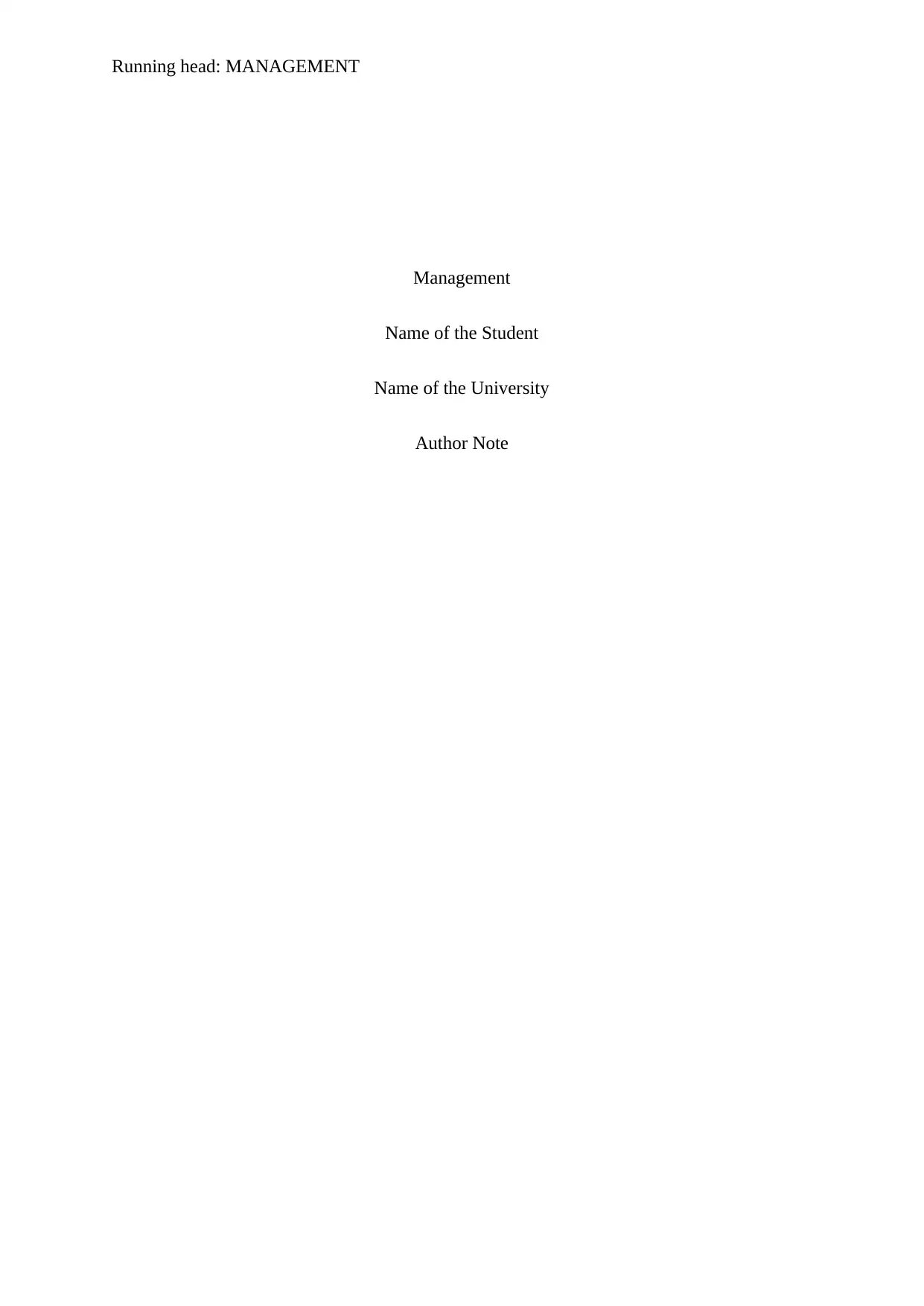
Running head: MANAGEMENT
Management
Name of the Student
Name of the University
Author Note
Management
Name of the Student
Name of the University
Author Note
Paraphrase This Document
Need a fresh take? Get an instant paraphrase of this document with our AI Paraphraser
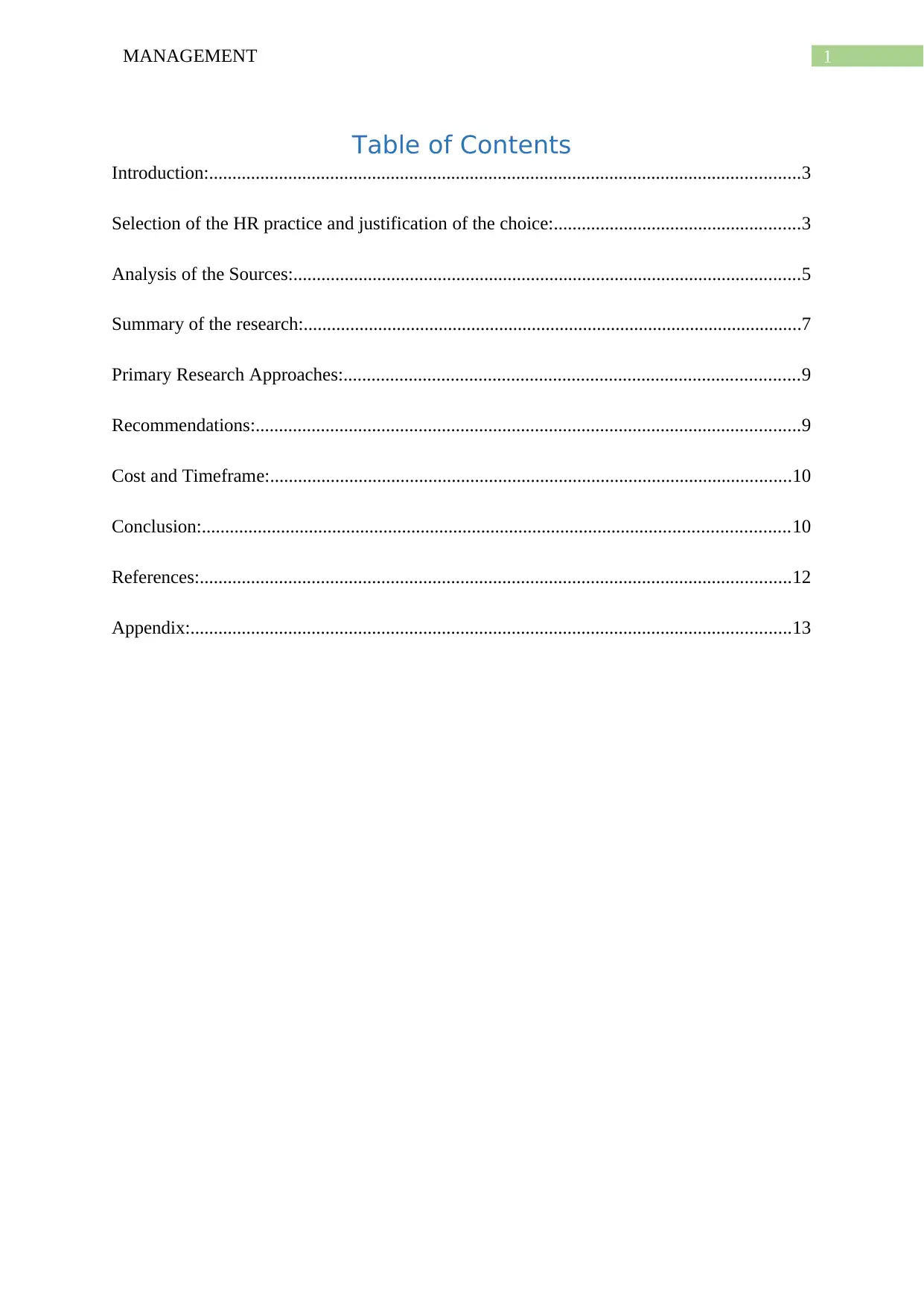
1MANAGEMENT
Table of Contents
Introduction:...............................................................................................................................3
Selection of the HR practice and justification of the choice:.....................................................3
Analysis of the Sources:.............................................................................................................5
Summary of the research:...........................................................................................................7
Primary Research Approaches:..................................................................................................9
Recommendations:.....................................................................................................................9
Cost and Timeframe:................................................................................................................10
Conclusion:..............................................................................................................................10
References:...............................................................................................................................12
Appendix:.................................................................................................................................13
Table of Contents
Introduction:...............................................................................................................................3
Selection of the HR practice and justification of the choice:.....................................................3
Analysis of the Sources:.............................................................................................................5
Summary of the research:...........................................................................................................7
Primary Research Approaches:..................................................................................................9
Recommendations:.....................................................................................................................9
Cost and Timeframe:................................................................................................................10
Conclusion:..............................................................................................................................10
References:...............................................................................................................................12
Appendix:.................................................................................................................................13
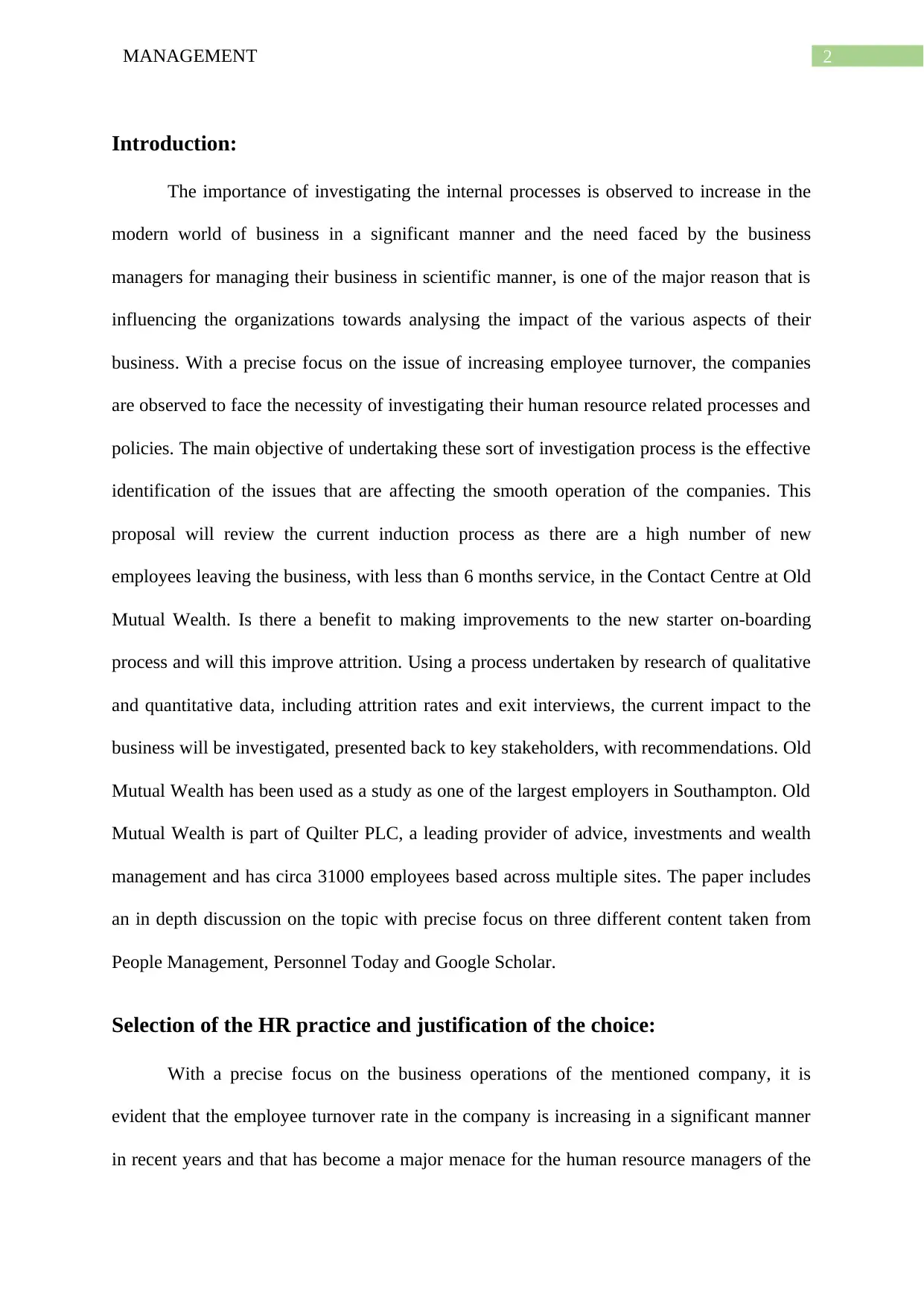
2MANAGEMENT
Introduction:
The importance of investigating the internal processes is observed to increase in the
modern world of business in a significant manner and the need faced by the business
managers for managing their business in scientific manner, is one of the major reason that is
influencing the organizations towards analysing the impact of the various aspects of their
business. With a precise focus on the issue of increasing employee turnover, the companies
are observed to face the necessity of investigating their human resource related processes and
policies. The main objective of undertaking these sort of investigation process is the effective
identification of the issues that are affecting the smooth operation of the companies. This
proposal will review the current induction process as there are a high number of new
employees leaving the business, with less than 6 months service, in the Contact Centre at Old
Mutual Wealth. Is there a benefit to making improvements to the new starter on-boarding
process and will this improve attrition. Using a process undertaken by research of qualitative
and quantitative data, including attrition rates and exit interviews, the current impact to the
business will be investigated, presented back to key stakeholders, with recommendations. Old
Mutual Wealth has been used as a study as one of the largest employers in Southampton. Old
Mutual Wealth is part of Quilter PLC, a leading provider of advice, investments and wealth
management and has circa 31000 employees based across multiple sites. The paper includes
an in depth discussion on the topic with precise focus on three different content taken from
People Management, Personnel Today and Google Scholar.
Selection of the HR practice and justification of the choice:
With a precise focus on the business operations of the mentioned company, it is
evident that the employee turnover rate in the company is increasing in a significant manner
in recent years and that has become a major menace for the human resource managers of the
Introduction:
The importance of investigating the internal processes is observed to increase in the
modern world of business in a significant manner and the need faced by the business
managers for managing their business in scientific manner, is one of the major reason that is
influencing the organizations towards analysing the impact of the various aspects of their
business. With a precise focus on the issue of increasing employee turnover, the companies
are observed to face the necessity of investigating their human resource related processes and
policies. The main objective of undertaking these sort of investigation process is the effective
identification of the issues that are affecting the smooth operation of the companies. This
proposal will review the current induction process as there are a high number of new
employees leaving the business, with less than 6 months service, in the Contact Centre at Old
Mutual Wealth. Is there a benefit to making improvements to the new starter on-boarding
process and will this improve attrition. Using a process undertaken by research of qualitative
and quantitative data, including attrition rates and exit interviews, the current impact to the
business will be investigated, presented back to key stakeholders, with recommendations. Old
Mutual Wealth has been used as a study as one of the largest employers in Southampton. Old
Mutual Wealth is part of Quilter PLC, a leading provider of advice, investments and wealth
management and has circa 31000 employees based across multiple sites. The paper includes
an in depth discussion on the topic with precise focus on three different content taken from
People Management, Personnel Today and Google Scholar.
Selection of the HR practice and justification of the choice:
With a precise focus on the business operations of the mentioned company, it is
evident that the employee turnover rate in the company is increasing in a significant manner
in recent years and that has become a major menace for the human resource managers of the
⊘ This is a preview!⊘
Do you want full access?
Subscribe today to unlock all pages.

Trusted by 1+ million students worldwide
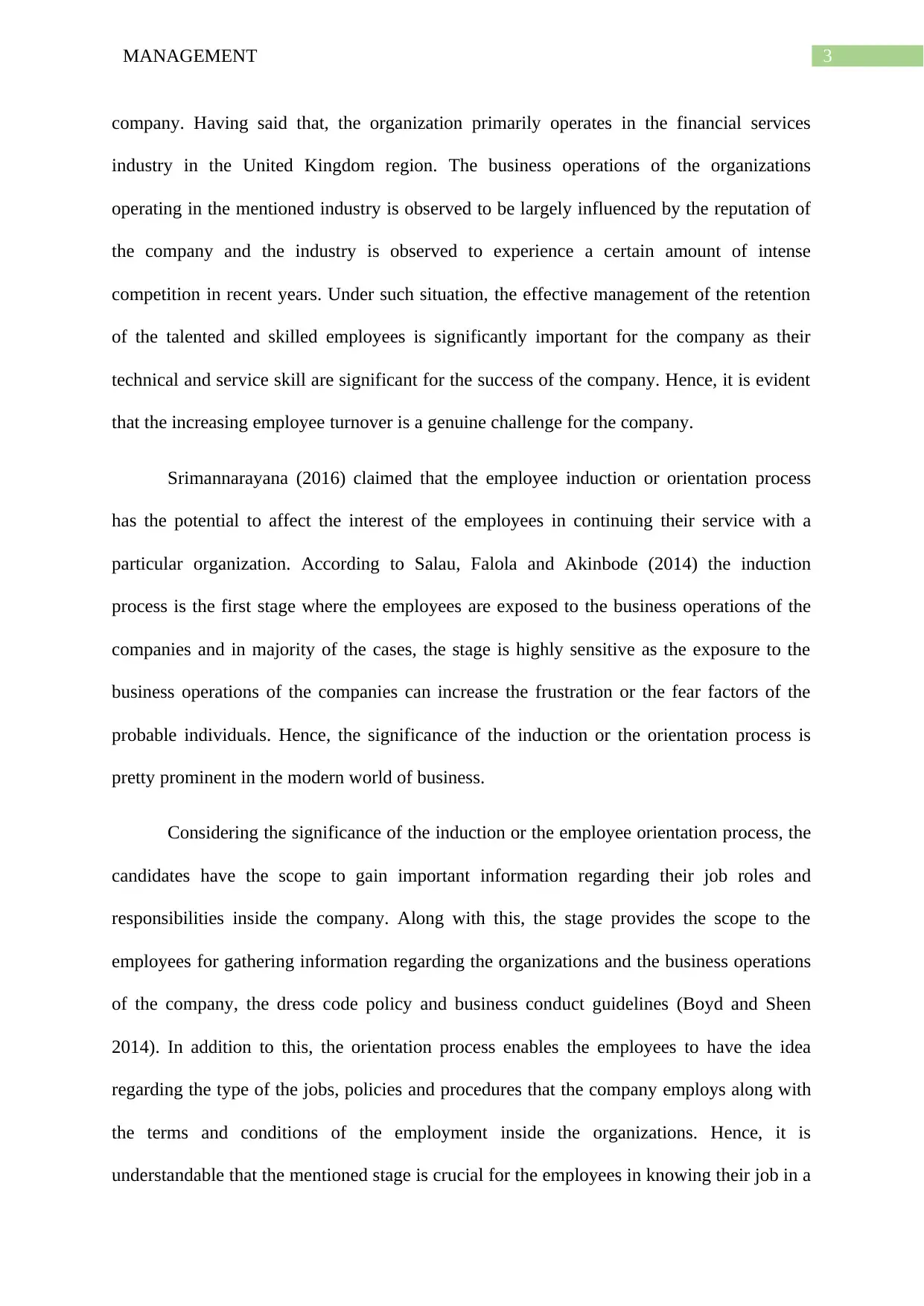
3MANAGEMENT
company. Having said that, the organization primarily operates in the financial services
industry in the United Kingdom region. The business operations of the organizations
operating in the mentioned industry is observed to be largely influenced by the reputation of
the company and the industry is observed to experience a certain amount of intense
competition in recent years. Under such situation, the effective management of the retention
of the talented and skilled employees is significantly important for the company as their
technical and service skill are significant for the success of the company. Hence, it is evident
that the increasing employee turnover is a genuine challenge for the company.
Srimannarayana (2016) claimed that the employee induction or orientation process
has the potential to affect the interest of the employees in continuing their service with a
particular organization. According to Salau, Falola and Akinbode (2014) the induction
process is the first stage where the employees are exposed to the business operations of the
companies and in majority of the cases, the stage is highly sensitive as the exposure to the
business operations of the companies can increase the frustration or the fear factors of the
probable individuals. Hence, the significance of the induction or the orientation process is
pretty prominent in the modern world of business.
Considering the significance of the induction or the employee orientation process, the
candidates have the scope to gain important information regarding their job roles and
responsibilities inside the company. Along with this, the stage provides the scope to the
employees for gathering information regarding the organizations and the business operations
of the company, the dress code policy and business conduct guidelines (Boyd and Sheen
2014). In addition to this, the orientation process enables the employees to have the idea
regarding the type of the jobs, policies and procedures that the company employs along with
the terms and conditions of the employment inside the organizations. Hence, it is
understandable that the mentioned stage is crucial for the employees in knowing their job in a
company. Having said that, the organization primarily operates in the financial services
industry in the United Kingdom region. The business operations of the organizations
operating in the mentioned industry is observed to be largely influenced by the reputation of
the company and the industry is observed to experience a certain amount of intense
competition in recent years. Under such situation, the effective management of the retention
of the talented and skilled employees is significantly important for the company as their
technical and service skill are significant for the success of the company. Hence, it is evident
that the increasing employee turnover is a genuine challenge for the company.
Srimannarayana (2016) claimed that the employee induction or orientation process
has the potential to affect the interest of the employees in continuing their service with a
particular organization. According to Salau, Falola and Akinbode (2014) the induction
process is the first stage where the employees are exposed to the business operations of the
companies and in majority of the cases, the stage is highly sensitive as the exposure to the
business operations of the companies can increase the frustration or the fear factors of the
probable individuals. Hence, the significance of the induction or the orientation process is
pretty prominent in the modern world of business.
Considering the significance of the induction or the employee orientation process, the
candidates have the scope to gain important information regarding their job roles and
responsibilities inside the company. Along with this, the stage provides the scope to the
employees for gathering information regarding the organizations and the business operations
of the company, the dress code policy and business conduct guidelines (Boyd and Sheen
2014). In addition to this, the orientation process enables the employees to have the idea
regarding the type of the jobs, policies and procedures that the company employs along with
the terms and conditions of the employment inside the organizations. Hence, it is
understandable that the mentioned stage is crucial for the employees in knowing their job in a
Paraphrase This Document
Need a fresh take? Get an instant paraphrase of this document with our AI Paraphraser
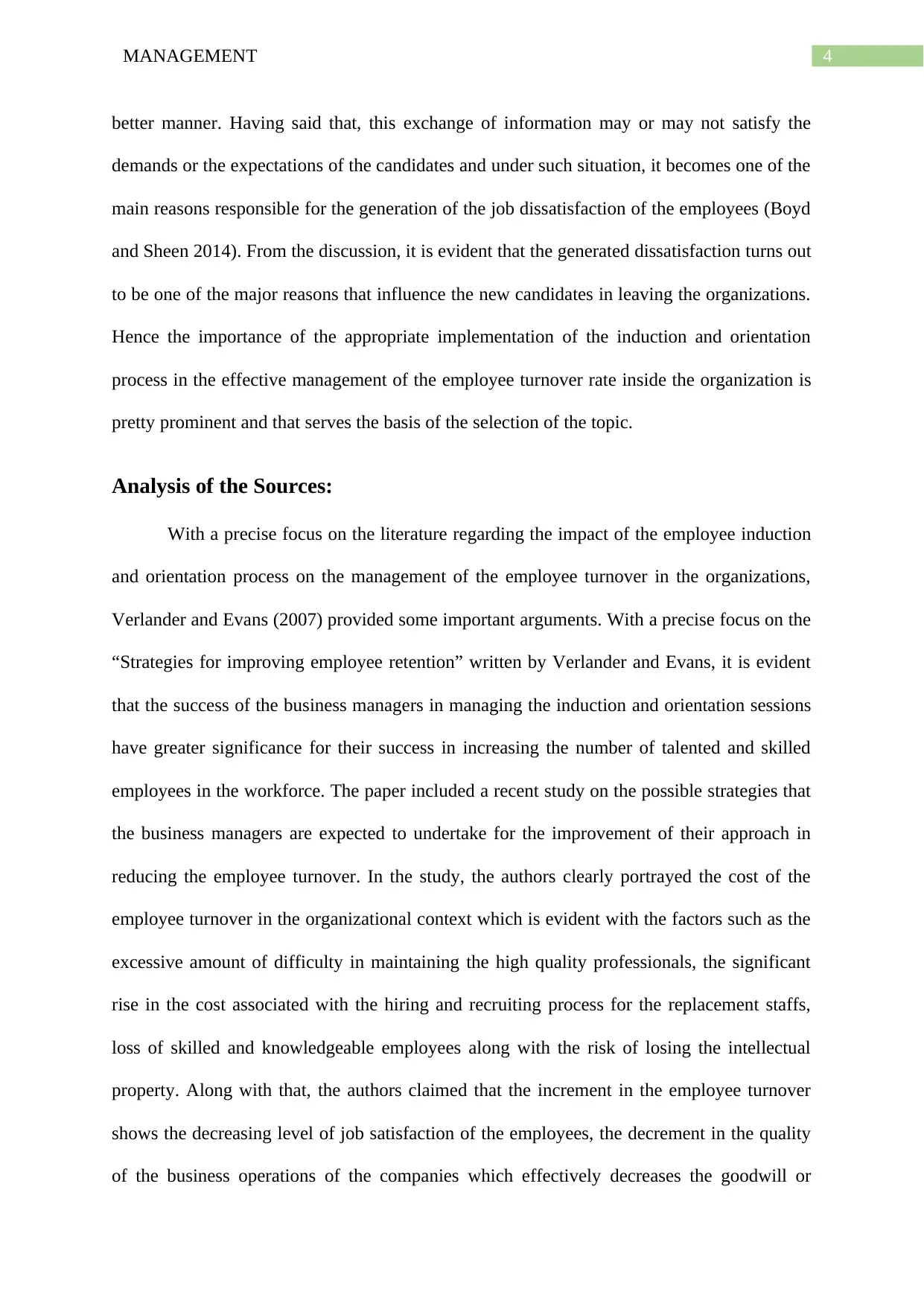
4MANAGEMENT
better manner. Having said that, this exchange of information may or may not satisfy the
demands or the expectations of the candidates and under such situation, it becomes one of the
main reasons responsible for the generation of the job dissatisfaction of the employees (Boyd
and Sheen 2014). From the discussion, it is evident that the generated dissatisfaction turns out
to be one of the major reasons that influence the new candidates in leaving the organizations.
Hence the importance of the appropriate implementation of the induction and orientation
process in the effective management of the employee turnover rate inside the organization is
pretty prominent and that serves the basis of the selection of the topic.
Analysis of the Sources:
With a precise focus on the literature regarding the impact of the employee induction
and orientation process on the management of the employee turnover in the organizations,
Verlander and Evans (2007) provided some important arguments. With a precise focus on the
“Strategies for improving employee retention” written by Verlander and Evans, it is evident
that the success of the business managers in managing the induction and orientation sessions
have greater significance for their success in increasing the number of talented and skilled
employees in the workforce. The paper included a recent study on the possible strategies that
the business managers are expected to undertake for the improvement of their approach in
reducing the employee turnover. In the study, the authors clearly portrayed the cost of the
employee turnover in the organizational context which is evident with the factors such as the
excessive amount of difficulty in maintaining the high quality professionals, the significant
rise in the cost associated with the hiring and recruiting process for the replacement staffs,
loss of skilled and knowledgeable employees along with the risk of losing the intellectual
property. Along with that, the authors claimed that the increment in the employee turnover
shows the decreasing level of job satisfaction of the employees, the decrement in the quality
of the business operations of the companies which effectively decreases the goodwill or
better manner. Having said that, this exchange of information may or may not satisfy the
demands or the expectations of the candidates and under such situation, it becomes one of the
main reasons responsible for the generation of the job dissatisfaction of the employees (Boyd
and Sheen 2014). From the discussion, it is evident that the generated dissatisfaction turns out
to be one of the major reasons that influence the new candidates in leaving the organizations.
Hence the importance of the appropriate implementation of the induction and orientation
process in the effective management of the employee turnover rate inside the organization is
pretty prominent and that serves the basis of the selection of the topic.
Analysis of the Sources:
With a precise focus on the literature regarding the impact of the employee induction
and orientation process on the management of the employee turnover in the organizations,
Verlander and Evans (2007) provided some important arguments. With a precise focus on the
“Strategies for improving employee retention” written by Verlander and Evans, it is evident
that the success of the business managers in managing the induction and orientation sessions
have greater significance for their success in increasing the number of talented and skilled
employees in the workforce. The paper included a recent study on the possible strategies that
the business managers are expected to undertake for the improvement of their approach in
reducing the employee turnover. In the study, the authors clearly portrayed the cost of the
employee turnover in the organizational context which is evident with the factors such as the
excessive amount of difficulty in maintaining the high quality professionals, the significant
rise in the cost associated with the hiring and recruiting process for the replacement staffs,
loss of skilled and knowledgeable employees along with the risk of losing the intellectual
property. Along with that, the authors claimed that the increment in the employee turnover
shows the decreasing level of job satisfaction of the employees, the decrement in the quality
of the business operations of the companies which effectively decreases the goodwill or
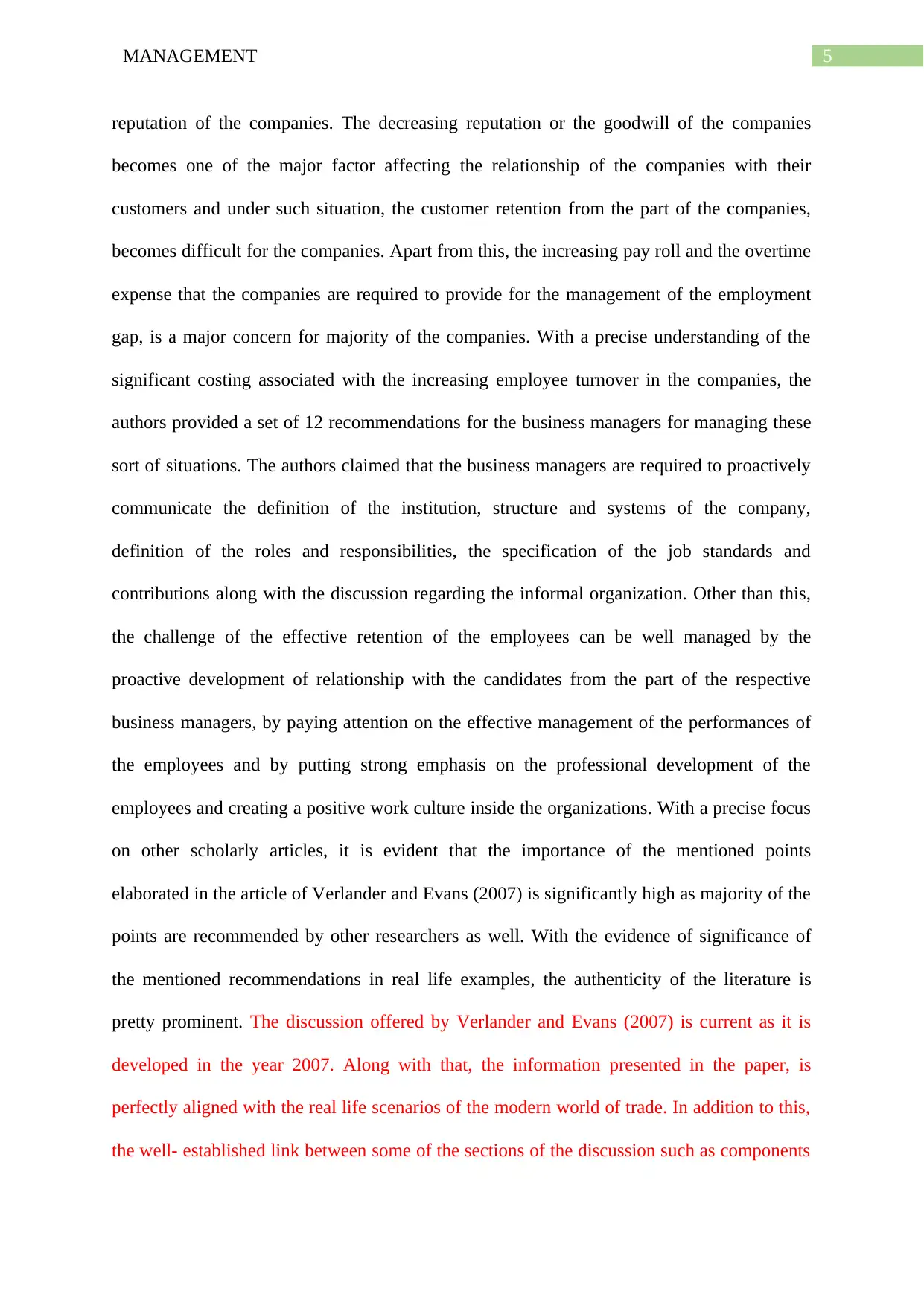
5MANAGEMENT
reputation of the companies. The decreasing reputation or the goodwill of the companies
becomes one of the major factor affecting the relationship of the companies with their
customers and under such situation, the customer retention from the part of the companies,
becomes difficult for the companies. Apart from this, the increasing pay roll and the overtime
expense that the companies are required to provide for the management of the employment
gap, is a major concern for majority of the companies. With a precise understanding of the
significant costing associated with the increasing employee turnover in the companies, the
authors provided a set of 12 recommendations for the business managers for managing these
sort of situations. The authors claimed that the business managers are required to proactively
communicate the definition of the institution, structure and systems of the company,
definition of the roles and responsibilities, the specification of the job standards and
contributions along with the discussion regarding the informal organization. Other than this,
the challenge of the effective retention of the employees can be well managed by the
proactive development of relationship with the candidates from the part of the respective
business managers, by paying attention on the effective management of the performances of
the employees and by putting strong emphasis on the professional development of the
employees and creating a positive work culture inside the organizations. With a precise focus
on other scholarly articles, it is evident that the importance of the mentioned points
elaborated in the article of Verlander and Evans (2007) is significantly high as majority of the
points are recommended by other researchers as well. With the evidence of significance of
the mentioned recommendations in real life examples, the authenticity of the literature is
pretty prominent. The discussion offered by Verlander and Evans (2007) is current as it is
developed in the year 2007. Along with that, the information presented in the paper, is
perfectly aligned with the real life scenarios of the modern world of trade. In addition to this,
the well- established link between some of the sections of the discussion such as components
reputation of the companies. The decreasing reputation or the goodwill of the companies
becomes one of the major factor affecting the relationship of the companies with their
customers and under such situation, the customer retention from the part of the companies,
becomes difficult for the companies. Apart from this, the increasing pay roll and the overtime
expense that the companies are required to provide for the management of the employment
gap, is a major concern for majority of the companies. With a precise understanding of the
significant costing associated with the increasing employee turnover in the companies, the
authors provided a set of 12 recommendations for the business managers for managing these
sort of situations. The authors claimed that the business managers are required to proactively
communicate the definition of the institution, structure and systems of the company,
definition of the roles and responsibilities, the specification of the job standards and
contributions along with the discussion regarding the informal organization. Other than this,
the challenge of the effective retention of the employees can be well managed by the
proactive development of relationship with the candidates from the part of the respective
business managers, by paying attention on the effective management of the performances of
the employees and by putting strong emphasis on the professional development of the
employees and creating a positive work culture inside the organizations. With a precise focus
on other scholarly articles, it is evident that the importance of the mentioned points
elaborated in the article of Verlander and Evans (2007) is significantly high as majority of the
points are recommended by other researchers as well. With the evidence of significance of
the mentioned recommendations in real life examples, the authenticity of the literature is
pretty prominent. The discussion offered by Verlander and Evans (2007) is current as it is
developed in the year 2007. Along with that, the information presented in the paper, is
perfectly aligned with the real life scenarios of the modern world of trade. In addition to this,
the well- established link between some of the sections of the discussion such as components
⊘ This is a preview!⊘
Do you want full access?
Subscribe today to unlock all pages.

Trusted by 1+ million students worldwide
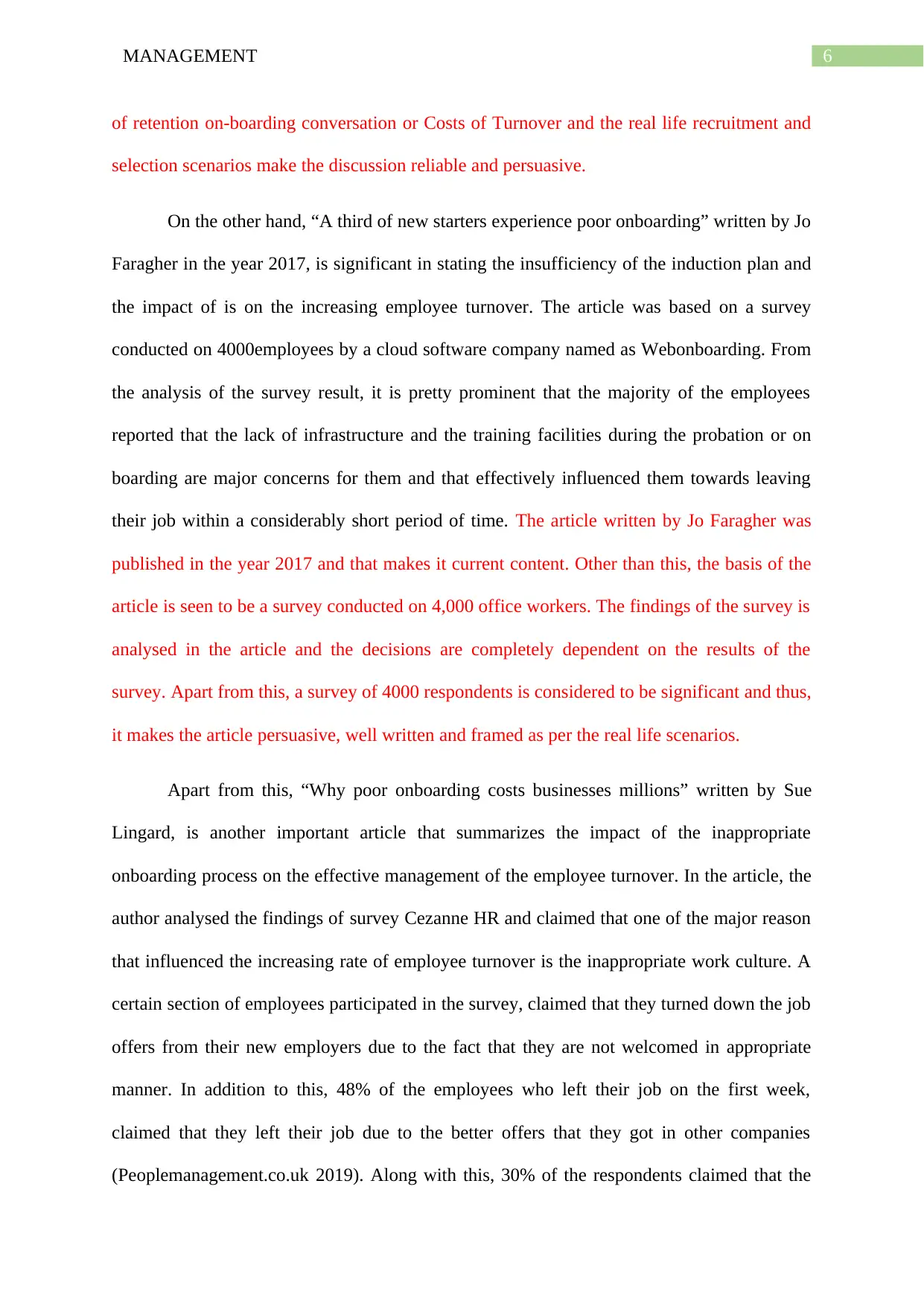
6MANAGEMENT
of retention on-boarding conversation or Costs of Turnover and the real life recruitment and
selection scenarios make the discussion reliable and persuasive.
On the other hand, “A third of new starters experience poor onboarding” written by Jo
Faragher in the year 2017, is significant in stating the insufficiency of the induction plan and
the impact of is on the increasing employee turnover. The article was based on a survey
conducted on 4000employees by a cloud software company named as Webonboarding. From
the analysis of the survey result, it is pretty prominent that the majority of the employees
reported that the lack of infrastructure and the training facilities during the probation or on
boarding are major concerns for them and that effectively influenced them towards leaving
their job within a considerably short period of time. The article written by Jo Faragher was
published in the year 2017 and that makes it current content. Other than this, the basis of the
article is seen to be a survey conducted on 4,000 office workers. The findings of the survey is
analysed in the article and the decisions are completely dependent on the results of the
survey. Apart from this, a survey of 4000 respondents is considered to be significant and thus,
it makes the article persuasive, well written and framed as per the real life scenarios.
Apart from this, “Why poor onboarding costs businesses millions” written by Sue
Lingard, is another important article that summarizes the impact of the inappropriate
onboarding process on the effective management of the employee turnover. In the article, the
author analysed the findings of survey Cezanne HR and claimed that one of the major reason
that influenced the increasing rate of employee turnover is the inappropriate work culture. A
certain section of employees participated in the survey, claimed that they turned down the job
offers from their new employers due to the fact that they are not welcomed in appropriate
manner. In addition to this, 48% of the employees who left their job on the first week,
claimed that they left their job due to the better offers that they got in other companies
(Peoplemanagement.co.uk 2019). Along with this, 30% of the respondents claimed that the
of retention on-boarding conversation or Costs of Turnover and the real life recruitment and
selection scenarios make the discussion reliable and persuasive.
On the other hand, “A third of new starters experience poor onboarding” written by Jo
Faragher in the year 2017, is significant in stating the insufficiency of the induction plan and
the impact of is on the increasing employee turnover. The article was based on a survey
conducted on 4000employees by a cloud software company named as Webonboarding. From
the analysis of the survey result, it is pretty prominent that the majority of the employees
reported that the lack of infrastructure and the training facilities during the probation or on
boarding are major concerns for them and that effectively influenced them towards leaving
their job within a considerably short period of time. The article written by Jo Faragher was
published in the year 2017 and that makes it current content. Other than this, the basis of the
article is seen to be a survey conducted on 4,000 office workers. The findings of the survey is
analysed in the article and the decisions are completely dependent on the results of the
survey. Apart from this, a survey of 4000 respondents is considered to be significant and thus,
it makes the article persuasive, well written and framed as per the real life scenarios.
Apart from this, “Why poor onboarding costs businesses millions” written by Sue
Lingard, is another important article that summarizes the impact of the inappropriate
onboarding process on the effective management of the employee turnover. In the article, the
author analysed the findings of survey Cezanne HR and claimed that one of the major reason
that influenced the increasing rate of employee turnover is the inappropriate work culture. A
certain section of employees participated in the survey, claimed that they turned down the job
offers from their new employers due to the fact that they are not welcomed in appropriate
manner. In addition to this, 48% of the employees who left their job on the first week,
claimed that they left their job due to the better offers that they got in other companies
(Peoplemanagement.co.uk 2019). Along with this, 30% of the respondents claimed that the
Paraphrase This Document
Need a fresh take? Get an instant paraphrase of this document with our AI Paraphraser
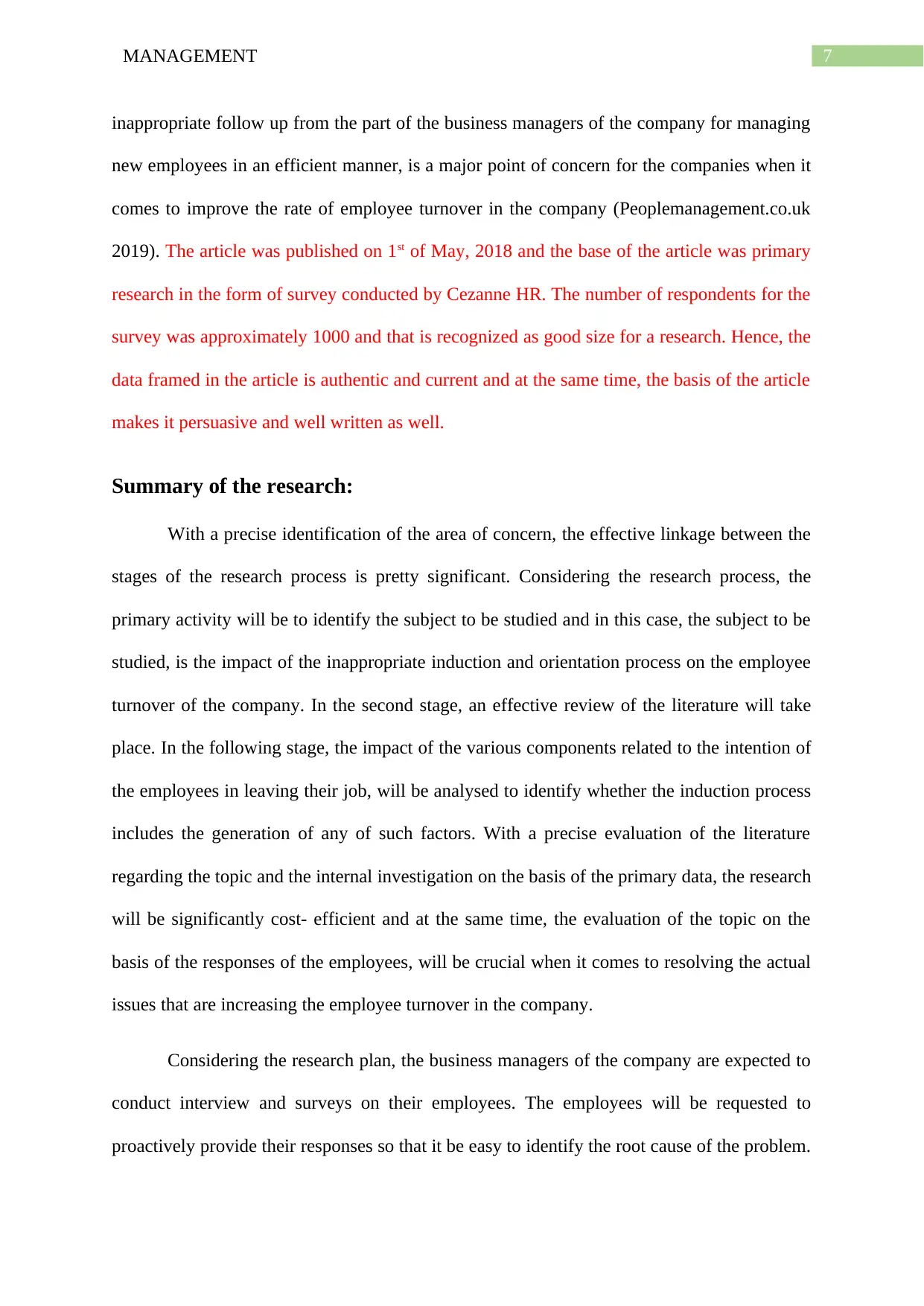
7MANAGEMENT
inappropriate follow up from the part of the business managers of the company for managing
new employees in an efficient manner, is a major point of concern for the companies when it
comes to improve the rate of employee turnover in the company (Peoplemanagement.co.uk
2019). The article was published on 1st of May, 2018 and the base of the article was primary
research in the form of survey conducted by Cezanne HR. The number of respondents for the
survey was approximately 1000 and that is recognized as good size for a research. Hence, the
data framed in the article is authentic and current and at the same time, the basis of the article
makes it persuasive and well written as well.
Summary of the research:
With a precise identification of the area of concern, the effective linkage between the
stages of the research process is pretty significant. Considering the research process, the
primary activity will be to identify the subject to be studied and in this case, the subject to be
studied, is the impact of the inappropriate induction and orientation process on the employee
turnover of the company. In the second stage, an effective review of the literature will take
place. In the following stage, the impact of the various components related to the intention of
the employees in leaving their job, will be analysed to identify whether the induction process
includes the generation of any of such factors. With a precise evaluation of the literature
regarding the topic and the internal investigation on the basis of the primary data, the research
will be significantly cost- efficient and at the same time, the evaluation of the topic on the
basis of the responses of the employees, will be crucial when it comes to resolving the actual
issues that are increasing the employee turnover in the company.
Considering the research plan, the business managers of the company are expected to
conduct interview and surveys on their employees. The employees will be requested to
proactively provide their responses so that it be easy to identify the root cause of the problem.
inappropriate follow up from the part of the business managers of the company for managing
new employees in an efficient manner, is a major point of concern for the companies when it
comes to improve the rate of employee turnover in the company (Peoplemanagement.co.uk
2019). The article was published on 1st of May, 2018 and the base of the article was primary
research in the form of survey conducted by Cezanne HR. The number of respondents for the
survey was approximately 1000 and that is recognized as good size for a research. Hence, the
data framed in the article is authentic and current and at the same time, the basis of the article
makes it persuasive and well written as well.
Summary of the research:
With a precise identification of the area of concern, the effective linkage between the
stages of the research process is pretty significant. Considering the research process, the
primary activity will be to identify the subject to be studied and in this case, the subject to be
studied, is the impact of the inappropriate induction and orientation process on the employee
turnover of the company. In the second stage, an effective review of the literature will take
place. In the following stage, the impact of the various components related to the intention of
the employees in leaving their job, will be analysed to identify whether the induction process
includes the generation of any of such factors. With a precise evaluation of the literature
regarding the topic and the internal investigation on the basis of the primary data, the research
will be significantly cost- efficient and at the same time, the evaluation of the topic on the
basis of the responses of the employees, will be crucial when it comes to resolving the actual
issues that are increasing the employee turnover in the company.
Considering the research plan, the business managers of the company are expected to
conduct interview and surveys on their employees. The employees will be requested to
proactively provide their responses so that it be easy to identify the root cause of the problem.
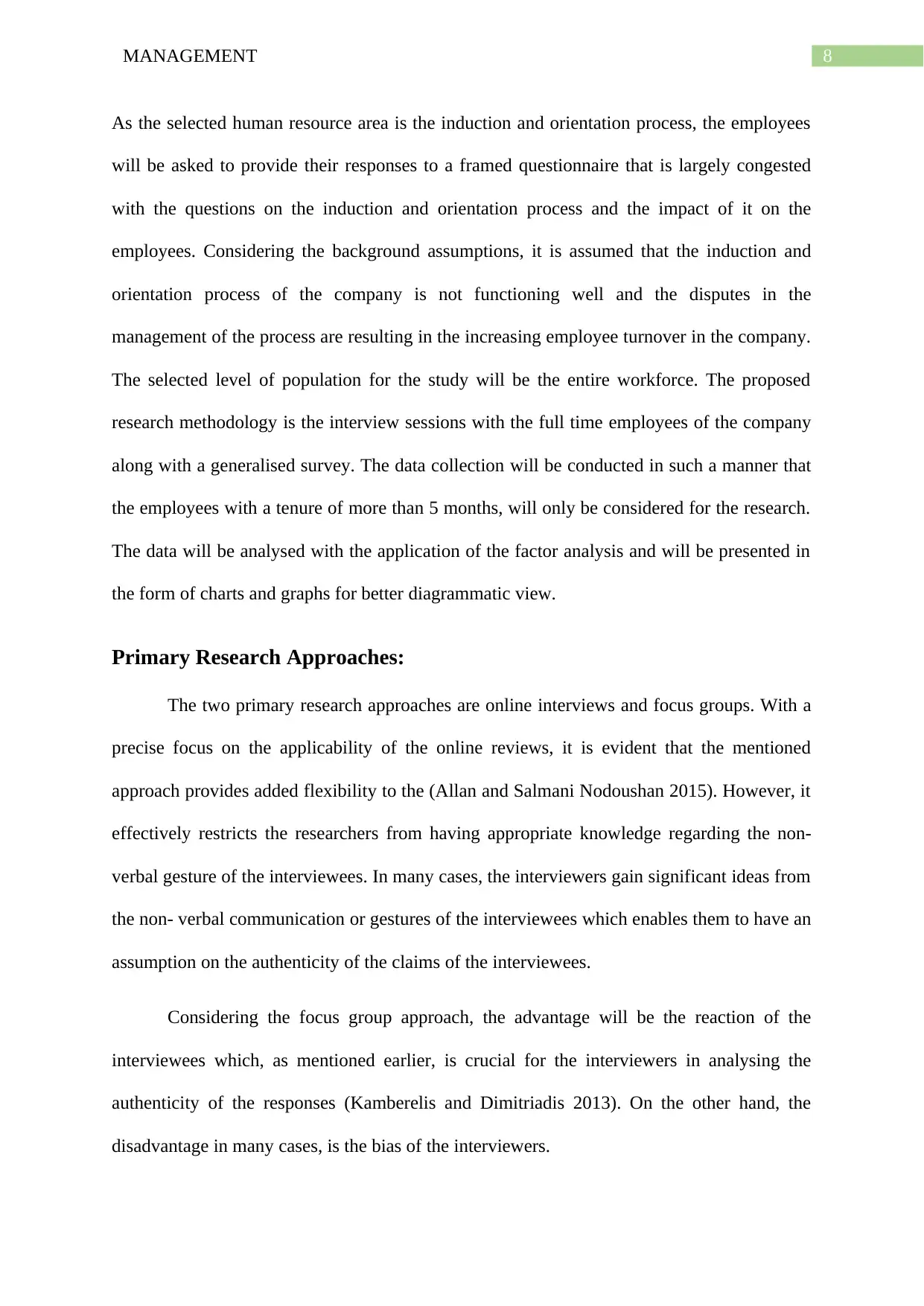
8MANAGEMENT
As the selected human resource area is the induction and orientation process, the employees
will be asked to provide their responses to a framed questionnaire that is largely congested
with the questions on the induction and orientation process and the impact of it on the
employees. Considering the background assumptions, it is assumed that the induction and
orientation process of the company is not functioning well and the disputes in the
management of the process are resulting in the increasing employee turnover in the company.
The selected level of population for the study will be the entire workforce. The proposed
research methodology is the interview sessions with the full time employees of the company
along with a generalised survey. The data collection will be conducted in such a manner that
the employees with a tenure of more than 5 months, will only be considered for the research.
The data will be analysed with the application of the factor analysis and will be presented in
the form of charts and graphs for better diagrammatic view.
Primary Research Approaches:
The two primary research approaches are online interviews and focus groups. With a
precise focus on the applicability of the online reviews, it is evident that the mentioned
approach provides added flexibility to the (Allan and Salmani Nodoushan 2015). However, it
effectively restricts the researchers from having appropriate knowledge regarding the non-
verbal gesture of the interviewees. In many cases, the interviewers gain significant ideas from
the non- verbal communication or gestures of the interviewees which enables them to have an
assumption on the authenticity of the claims of the interviewees.
Considering the focus group approach, the advantage will be the reaction of the
interviewees which, as mentioned earlier, is crucial for the interviewers in analysing the
authenticity of the responses (Kamberelis and Dimitriadis 2013). On the other hand, the
disadvantage in many cases, is the bias of the interviewers.
As the selected human resource area is the induction and orientation process, the employees
will be asked to provide their responses to a framed questionnaire that is largely congested
with the questions on the induction and orientation process and the impact of it on the
employees. Considering the background assumptions, it is assumed that the induction and
orientation process of the company is not functioning well and the disputes in the
management of the process are resulting in the increasing employee turnover in the company.
The selected level of population for the study will be the entire workforce. The proposed
research methodology is the interview sessions with the full time employees of the company
along with a generalised survey. The data collection will be conducted in such a manner that
the employees with a tenure of more than 5 months, will only be considered for the research.
The data will be analysed with the application of the factor analysis and will be presented in
the form of charts and graphs for better diagrammatic view.
Primary Research Approaches:
The two primary research approaches are online interviews and focus groups. With a
precise focus on the applicability of the online reviews, it is evident that the mentioned
approach provides added flexibility to the (Allan and Salmani Nodoushan 2015). However, it
effectively restricts the researchers from having appropriate knowledge regarding the non-
verbal gesture of the interviewees. In many cases, the interviewers gain significant ideas from
the non- verbal communication or gestures of the interviewees which enables them to have an
assumption on the authenticity of the claims of the interviewees.
Considering the focus group approach, the advantage will be the reaction of the
interviewees which, as mentioned earlier, is crucial for the interviewers in analysing the
authenticity of the responses (Kamberelis and Dimitriadis 2013). On the other hand, the
disadvantage in many cases, is the bias of the interviewers.
⊘ This is a preview!⊘
Do you want full access?
Subscribe today to unlock all pages.

Trusted by 1+ million students worldwide
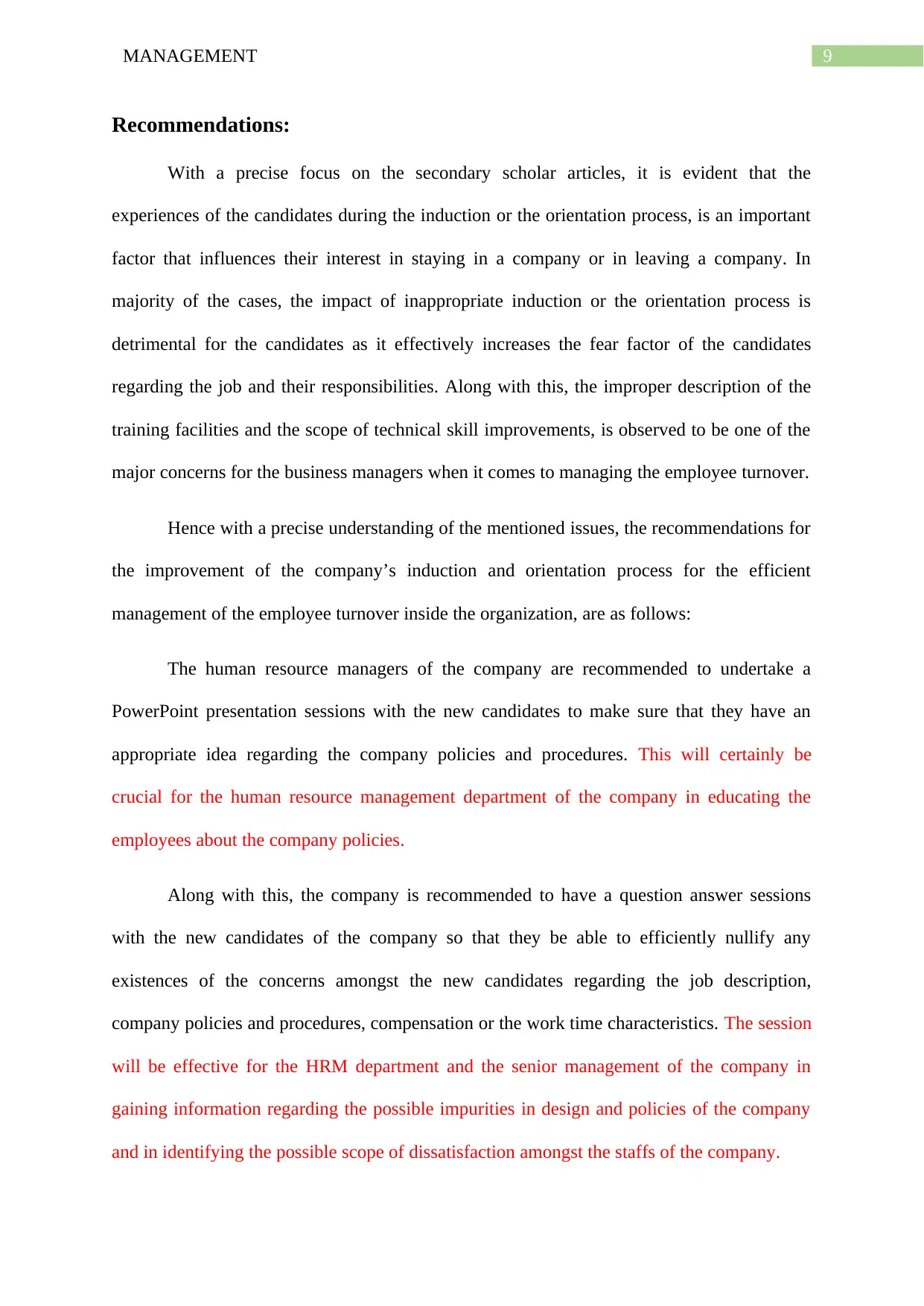
9MANAGEMENT
Recommendations:
With a precise focus on the secondary scholar articles, it is evident that the
experiences of the candidates during the induction or the orientation process, is an important
factor that influences their interest in staying in a company or in leaving a company. In
majority of the cases, the impact of inappropriate induction or the orientation process is
detrimental for the candidates as it effectively increases the fear factor of the candidates
regarding the job and their responsibilities. Along with this, the improper description of the
training facilities and the scope of technical skill improvements, is observed to be one of the
major concerns for the business managers when it comes to managing the employee turnover.
Hence with a precise understanding of the mentioned issues, the recommendations for
the improvement of the company’s induction and orientation process for the efficient
management of the employee turnover inside the organization, are as follows:
The human resource managers of the company are recommended to undertake a
PowerPoint presentation sessions with the new candidates to make sure that they have an
appropriate idea regarding the company policies and procedures. This will certainly be
crucial for the human resource management department of the company in educating the
employees about the company policies.
Along with this, the company is recommended to have a question answer sessions
with the new candidates of the company so that they be able to efficiently nullify any
existences of the concerns amongst the new candidates regarding the job description,
company policies and procedures, compensation or the work time characteristics. The session
will be effective for the HRM department and the senior management of the company in
gaining information regarding the possible impurities in design and policies of the company
and in identifying the possible scope of dissatisfaction amongst the staffs of the company.
Recommendations:
With a precise focus on the secondary scholar articles, it is evident that the
experiences of the candidates during the induction or the orientation process, is an important
factor that influences their interest in staying in a company or in leaving a company. In
majority of the cases, the impact of inappropriate induction or the orientation process is
detrimental for the candidates as it effectively increases the fear factor of the candidates
regarding the job and their responsibilities. Along with this, the improper description of the
training facilities and the scope of technical skill improvements, is observed to be one of the
major concerns for the business managers when it comes to managing the employee turnover.
Hence with a precise understanding of the mentioned issues, the recommendations for
the improvement of the company’s induction and orientation process for the efficient
management of the employee turnover inside the organization, are as follows:
The human resource managers of the company are recommended to undertake a
PowerPoint presentation sessions with the new candidates to make sure that they have an
appropriate idea regarding the company policies and procedures. This will certainly be
crucial for the human resource management department of the company in educating the
employees about the company policies.
Along with this, the company is recommended to have a question answer sessions
with the new candidates of the company so that they be able to efficiently nullify any
existences of the concerns amongst the new candidates regarding the job description,
company policies and procedures, compensation or the work time characteristics. The session
will be effective for the HRM department and the senior management of the company in
gaining information regarding the possible impurities in design and policies of the company
and in identifying the possible scope of dissatisfaction amongst the staffs of the company.
Paraphrase This Document
Need a fresh take? Get an instant paraphrase of this document with our AI Paraphraser
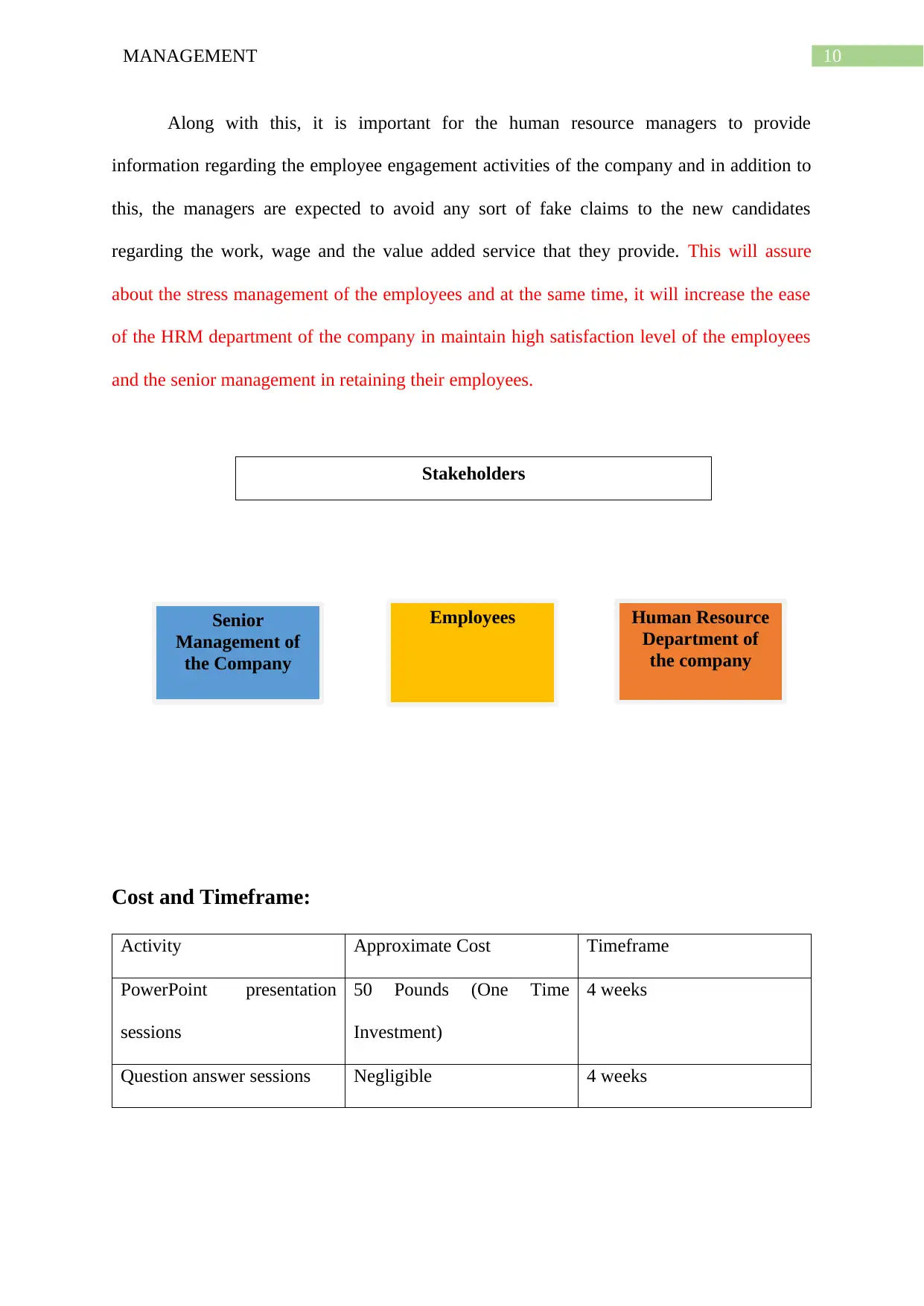
10MANAGEMENT
Stakeholders
Senior
Management of
the Company
Human Resource
Department of
the company
Employees
Along with this, it is important for the human resource managers to provide
information regarding the employee engagement activities of the company and in addition to
this, the managers are expected to avoid any sort of fake claims to the new candidates
regarding the work, wage and the value added service that they provide. This will assure
about the stress management of the employees and at the same time, it will increase the ease
of the HRM department of the company in maintain high satisfaction level of the employees
and the senior management in retaining their employees.
Cost and Timeframe:
Activity Approximate Cost Timeframe
PowerPoint presentation
sessions
50 Pounds (One Time
Investment)
4 weeks
Question answer sessions Negligible 4 weeks
Stakeholders
Senior
Management of
the Company
Human Resource
Department of
the company
Employees
Along with this, it is important for the human resource managers to provide
information regarding the employee engagement activities of the company and in addition to
this, the managers are expected to avoid any sort of fake claims to the new candidates
regarding the work, wage and the value added service that they provide. This will assure
about the stress management of the employees and at the same time, it will increase the ease
of the HRM department of the company in maintain high satisfaction level of the employees
and the senior management in retaining their employees.
Cost and Timeframe:
Activity Approximate Cost Timeframe
PowerPoint presentation
sessions
50 Pounds (One Time
Investment)
4 weeks
Question answer sessions Negligible 4 weeks

11MANAGEMENT
Employee engagement
activities
100 Pounds (Monthly) 4 weeks
Conclusion:
On a concluding note, it is visible that the effective management the induction and
orientation process is crucial for the success of the human resource managers in improving
their ability of managing the employees inside the organization. Considering the case of the
Old Mutual Wealth, the increasing rate of attrition is seen to be a major concern for the
managers and under such situation, the inappropriate and insufficient induction and
orientation process is playing the role of a key influencer for the increment of employee
turnover. The company is observed to have the capability to manage the mentioned
challenges with the improvement activities such as the PowerPoint presentation sessions,
question answer sessions, employee engagement activities and avoidance to the fake claims.
Employee engagement
activities
100 Pounds (Monthly) 4 weeks
Conclusion:
On a concluding note, it is visible that the effective management the induction and
orientation process is crucial for the success of the human resource managers in improving
their ability of managing the employees inside the organization. Considering the case of the
Old Mutual Wealth, the increasing rate of attrition is seen to be a major concern for the
managers and under such situation, the inappropriate and insufficient induction and
orientation process is playing the role of a key influencer for the increment of employee
turnover. The company is observed to have the capability to manage the mentioned
challenges with the improvement activities such as the PowerPoint presentation sessions,
question answer sessions, employee engagement activities and avoidance to the fake claims.
⊘ This is a preview!⊘
Do you want full access?
Subscribe today to unlock all pages.

Trusted by 1+ million students worldwide
1 out of 14
Related Documents
Your All-in-One AI-Powered Toolkit for Academic Success.
+13062052269
info@desklib.com
Available 24*7 on WhatsApp / Email
![[object Object]](/_next/static/media/star-bottom.7253800d.svg)
Unlock your academic potential
Copyright © 2020–2025 A2Z Services. All Rights Reserved. Developed and managed by ZUCOL.



